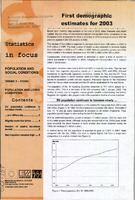Statistics in Focus: Population and social conditions. First demographic estimates for 2003.

Working Document
Author
EU Commission
Date
2003-12-15View/
Subject headings
Social policy ; Social Europe ; Demographics ; StatisticsAbstract
Based upon monthly data available at the end of 2003, latest forecasts and expert opinion, the net inflow of international migrants (immigration minus emigration) to the European Union is expected to show a decrease in 2003 to a level of around 983 OOO
persons, against 1 260 OOO persons in 2002. The number of live births is expected to increase slightly from 3.99 million in 2002 to 4.03 million in 2003. The total number of deaths is also expected to increase slightly from 3.68 million in 2002 to 3. 7 4 million in 2003. Natural population growth (live births minus deaths) is forecast to decrease from 309 OOO in 2002 to 294 OOO in 2003 .
Consequently, total population growth is estimated to reach a level of around 1.3 million (compared to 1.6 million in 2002), bringing the EU population on 1 January 2004 to 380.8 million. Population censuses were held in 2000 and 2001 in most EU countries. This has lead to lower than expected population counts on 1 January 2001 and 2002, followed sometimes by significantly (upwards) corrections, notably for Italy and the UK. There are therefore breaks in series between 2000 and 2003, resulting in discrepancies in figures for population growth and net migration. Population figures for the intercensal period for the countries concerned and the EU will be recalculated in the near future. The population of the 10 Acceding Countries amounted to 74.1 million people on 1 January 2004. This is a decrease of 60 OOO compared with 1 January 2003. This decline is mainly due to negative natural growth (deaths outnumbering live births). Negative net migration also played a role in the population decline of some countries.
